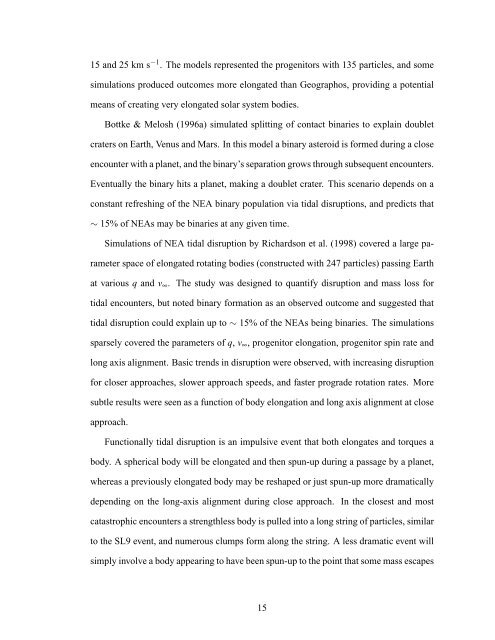Forming Binary Near-Earth Asteroids From Tidal Disruptions
Forming Binary Near-Earth Asteroids From Tidal Disruptions
Forming Binary Near-Earth Asteroids From Tidal Disruptions
Create successful ePaper yourself
Turn your PDF publications into a flip-book with our unique Google optimized e-Paper software.
15 and 25 km s −1 . The models represented the progenitors with 135 particles, and somesimulations produced outcomes more elongated than Geographos, providing a potentialmeans of creating very elongated solar system bodies.Bottke & Melosh (1996a) simulated splitting of contact binaries to explain doubletcraters on <strong>Earth</strong>, Venus and Mars. In this model a binary asteroid is formed during a closeencounter with a planet, and the binary’s separation grows through subsequent encounters.Eventually the binary hits a planet, making a doublet crater. This scenario depends on aconstant refreshing of the NEA binary population via tidal disruptions, and predicts that∼ 15% of NEAs may be binaries at any given time.Simulations of NEA tidal disruption by Richardson et al. (1998) covered a large parameterspace of elongated rotating bodies (constructed with 247 particles) passing <strong>Earth</strong>at various q and v ∞ . The study was designed to quantify disruption and mass loss fortidal encounters, but noted binary formation as an observed outcome and suggested thattidal disruption could explain up to ∼ 15% of the NEAs being binaries. The simulationssparsely covered the parameters of q, v ∞ , progenitor elongation, progenitor spin rate andlong axis alignment. Basic trends in disruption were observed, with increasing disruptionfor closer approaches, slower approach speeds, and faster prograde rotation rates. Moresubtle results were seen as a function of body elongation and long axis alignment at closeapproach.Functionally tidal disruption is an impulsive event that both elongates and torques abody. A spherical body will be elongated and then spun-up during a passage by a planet,whereas a previously elongated body may be reshaped or just spun-up more dramaticallydepending on the long-axis alignment during close approach. In the closest and mostcatastrophic encounters a strengthless body is pulled into a long string of particles, similarto the SL9 event, and numerous clumps form along the string. A less dramatic event willsimply involve a body appearing to have been spun-up to the point that some mass escapes15












